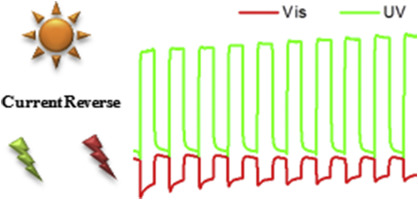Dyes and Pigments ( IF 4.5 ) Pub Date : 2018-09-28 , DOI: 10.1016/j.dyepig.2018.09.070 Lei Zhang , Cunyu Li , Jingfa Li , Fan Jiang

|
Photo-responsive molecules have been widely investigated since they exhibit potential applications in optoelectronics and molecular devices. Although the photocurrents in some photo-responsive systems can be successfully turned ‘on’ and ‘off’ via light irradiation, the modulation of the vastly different directions of electron flow have seldom been realized by light (i.e., induce electron flow in opposite directions simply by light). In this manuscript, we provide evidence that the electron flow directions could be successfully controlled by light, using a molecule/TiO2 hybrid system based on azo dyes (methyl red and ethyl red) as an example. In particular, a light-induced current exists when a UV light is employed, while the photocurrent direction isreversed when a visible light is employed. Possible origins of such peculiar photoelectrochemical behaviors are suggested, based on the optimized structures and electronic/optical properties determined from the first principles calculations. We expect that with further molecular engineering and structure optimization, the electron flow directions as well as the photocurrent intensities in functional materials could be better controlled by light, which provide a foundation for the fundamental understanding of the photo-responsive behaviors in advanced functional materials, and may pave the way for the design of novel optoelectronic devices and solar fuel systems in which the opposite electron transfer directions could be manipulated remotely by light sources.
中文翻译:

用光控制电子流向:以偶氮染料为载体的TiO 2薄膜的研究
由于光响应分子在光电子学和分子器件中显示出潜在的应用,因此已被广泛研究。尽管可以通过光照射成功地打开和关闭某些光响应系统中的光电流,但很少能通过光来实现对电子流的极大不同方向的调制(即,简单地沿相反方向感应电子流)通过光)。在本手稿中,我们提供了使用分子/ TiO 2可以成功地控制电子流向的证据以基于偶氮染料(甲基红和乙基红)的混合体系为例。特别地,当采用紫外光时,存在光感应电流,而当采用可见光时,光电流方向相反。根据从第一原理计算确定的优化结构和电子/光学特性,提出了这种特殊的光电化学行为的可能起源。我们期望通过进一步的分子工程和结构优化,功能材料中的电子流向和光电流强度可以通过光更好地控制,从而为对高级功能材料中光响应行为的基本理解提供了基础,



























 京公网安备 11010802027423号
京公网安备 11010802027423号